NASCAR is hosting its first ever street courses during the 2023 Fourth of July weekend right here in Chicago, inaugurating two separate races, the 100-lap Grand Park 220 and the 55-lap Loop 15. The Windy City is no stranger to automobile competitions. In 1895, the Chicago Times-Herald Race, the nation’s first automotive race, took place in Chicago and changed the course of US history.
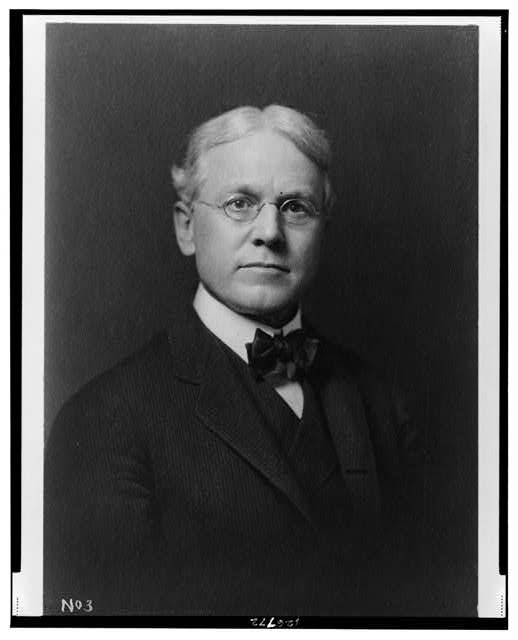
Herman H. Kohlsaat, head-and-shoulders portrait, c. 1903. Photograph. https://www.loc.gov/item/00652040/.
The competition was the idea of Herman Henry (H. H.) Kohlsaat, who made his fortune as an entrepreneur in the food industry and a newspaper publisher. Kohlsaat got the idea from a race that ran in 1895 from Paris to Bordeaux. His rationale for hosting one was two-pronged. He believed that travel by horse carriage would soon become a thing of the past due to the rapid pace of technological advancements, and hosting a race was a unique way to celebrate the fiftieth anniversary of the Chicago Times-Herald, of which he was the proprietor.
The race was originally scheduled to take place on July 4, 1895, to take advantage of the crowds already gathered in the city. However, the date was pushed back when many competitors requested more time to complete their racing machines. As part of the campaign to promote the competition, Kohlsaat held a contest in the Times-Herald asking readers to submit nominations for what they thought the new “self-propelling road carriages” should be called. After receiving many submissions, the newspaper declared “motocycle” the worthiest term, awarding the entrant a prize of $500 ($18,100 in 2023). Kohlsaat ended up rescheduling the Times-Herald Race for Thanksgiving 1895. Up for grabs was a $5,000 pot: $2,000 for first place, $1500 for second, $1000 for third, and $500 for fourth. (In 2023, $72,411 for 1st, $54,308 for 2nd, $36,206 for 3rd, and $18,103 for 4th).
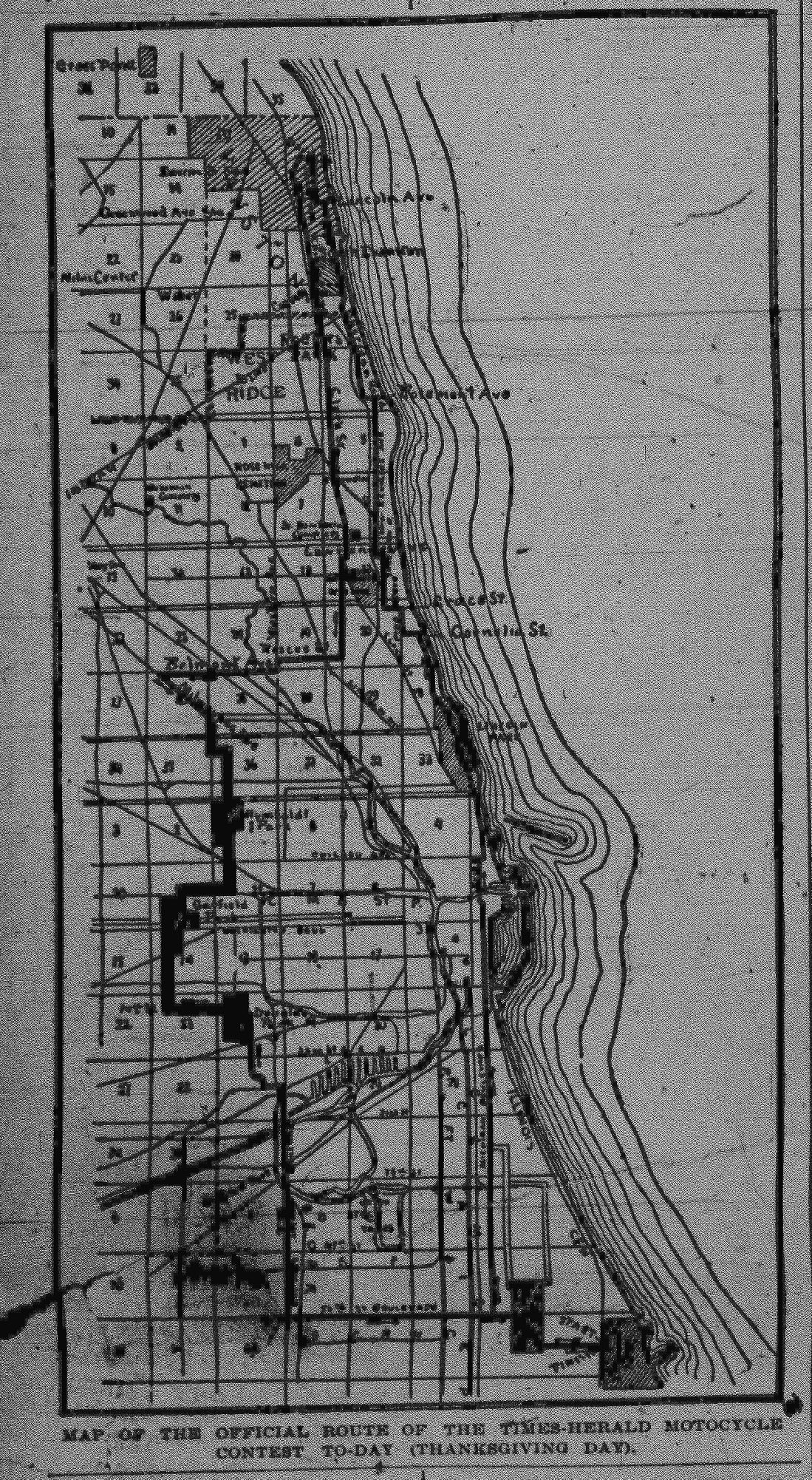
Map of the official route of the Times-Herald motocycle contest, from page 2 of the Chicago Times-Herald, November 28, 1895.
What few accounted for was Chicago weather in November. Initially, 80 competitors registered for the competition, but the night before the race, a snowstorm coated city streets with six inches of snow, which brought down the number of committed racers to eleven. At the morning lineup, only six vehicles made it to the starting line at the Midway Plaisance. While the original race plans had drivers going further north, the blizzard led to a significant modification in the track. Drivers would complete a loop from the city’s South Side to north suburban Evanston and back again. Altogether, the official distance of the race measured just over 50 miles.
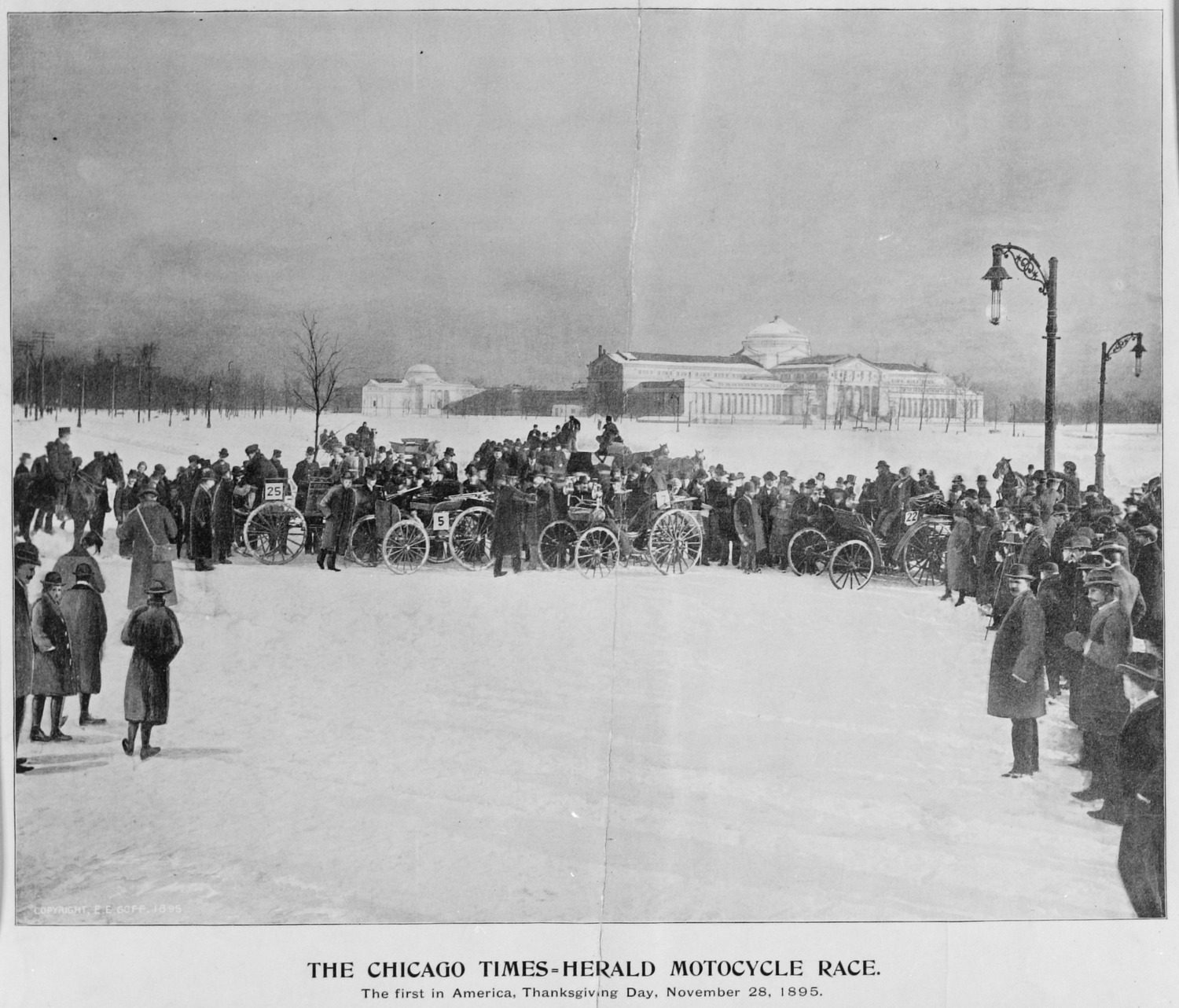
The start of the Chicago Times-Herald motocycle race, the first in the United States, on Thanksgiving Day, November 28. 1895. CHM, ICHi-003646
The six vehicles that lined up at 9:00 a.m. on race day were feats of engineering. Four of the six competitors powered their vehicles with gasoline. Three of the four gasoline vehicles were built by German engineer Karl Benz, the namesake of modern-day Mercedes Benz. One was sponsored by Hieronymus Mueller & Co. from Decatur, Illinois, the second by the De La Vergne Refrigerating Company, and the third by RH, Macy & Co., both of New York. The fourth gasoline-powered vehicle was the Duryea, made by the Duryea Motor Wagon Company based out of Massachusetts. The other two vehicles were electric and participated in the race not as serious contenders but instead to showcase the potential of electric drivetrains. The Morris and Salom Company from Philadelphia sponsored one, dubbed the Electrobat, while the other belonged to Chicagoan Harold Sturges, previously exhibited at the 1893 World’s Columbian Exposition.
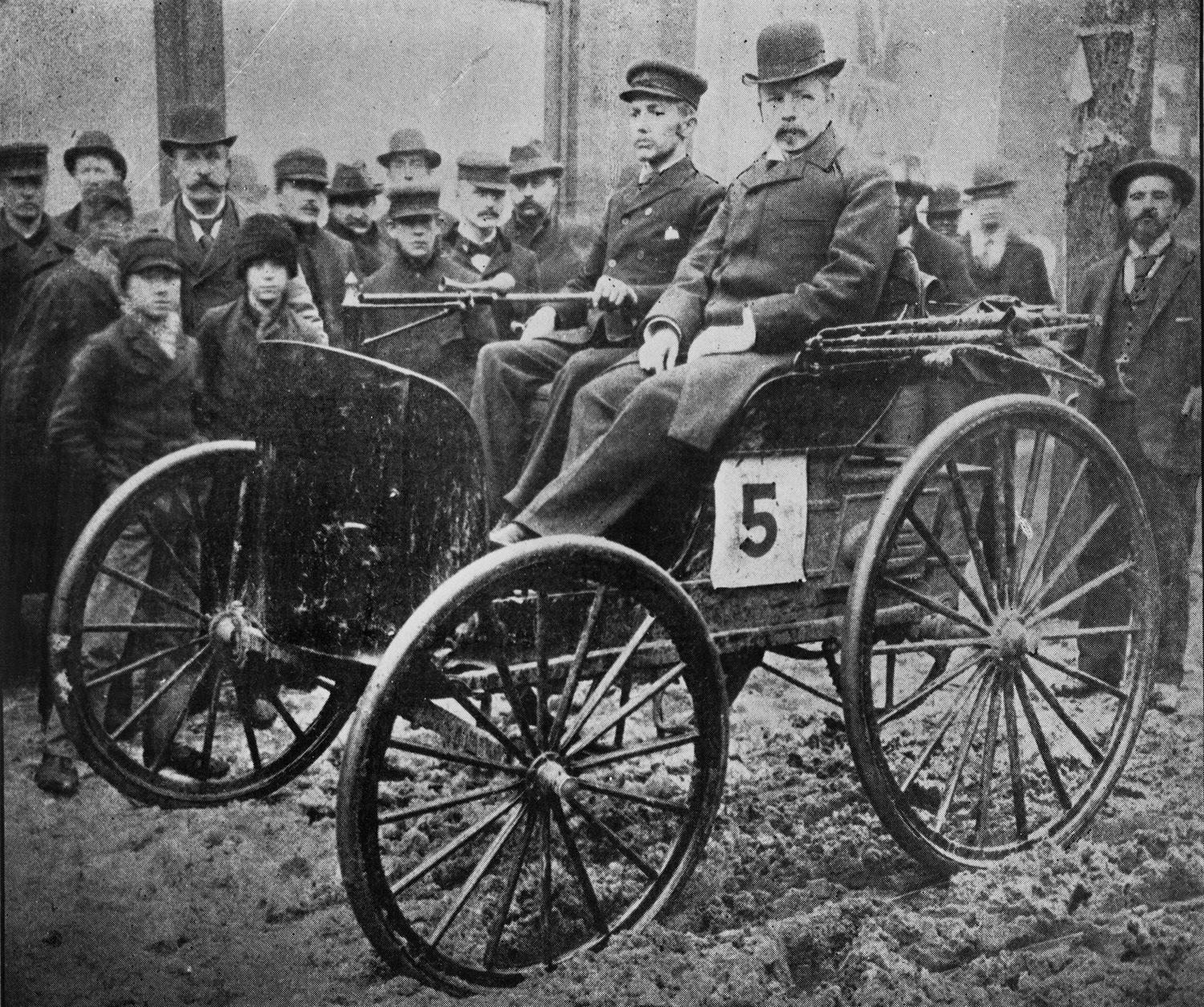
J. Frank Duryea, designer, builder, and driver of the automobile that won the Chicago Times-Herald race, with umpire Arthur W. White, November 28, 1895. CHM, ICHi-009009
The race was anything but high speed. Thanks to the weather, road conditions, and primitive engineering powering the vehicles, the average speed at which cars traveled the course was a whopping seven miles per hour. Additionally, every competitor needed to make space for a race umpire in their vehicle, who ensured that drivers kept to the course. After many starts, stops, and a breakdown or two, the American-made Duryea was the first to cross the finish line, logging over 10 hours on the road. Second place came to the Mueller Benz from Decatur. These two were the only competitors who completed the race, with the rest dropping out due to damage to their vehicles or equipment malfunctions.
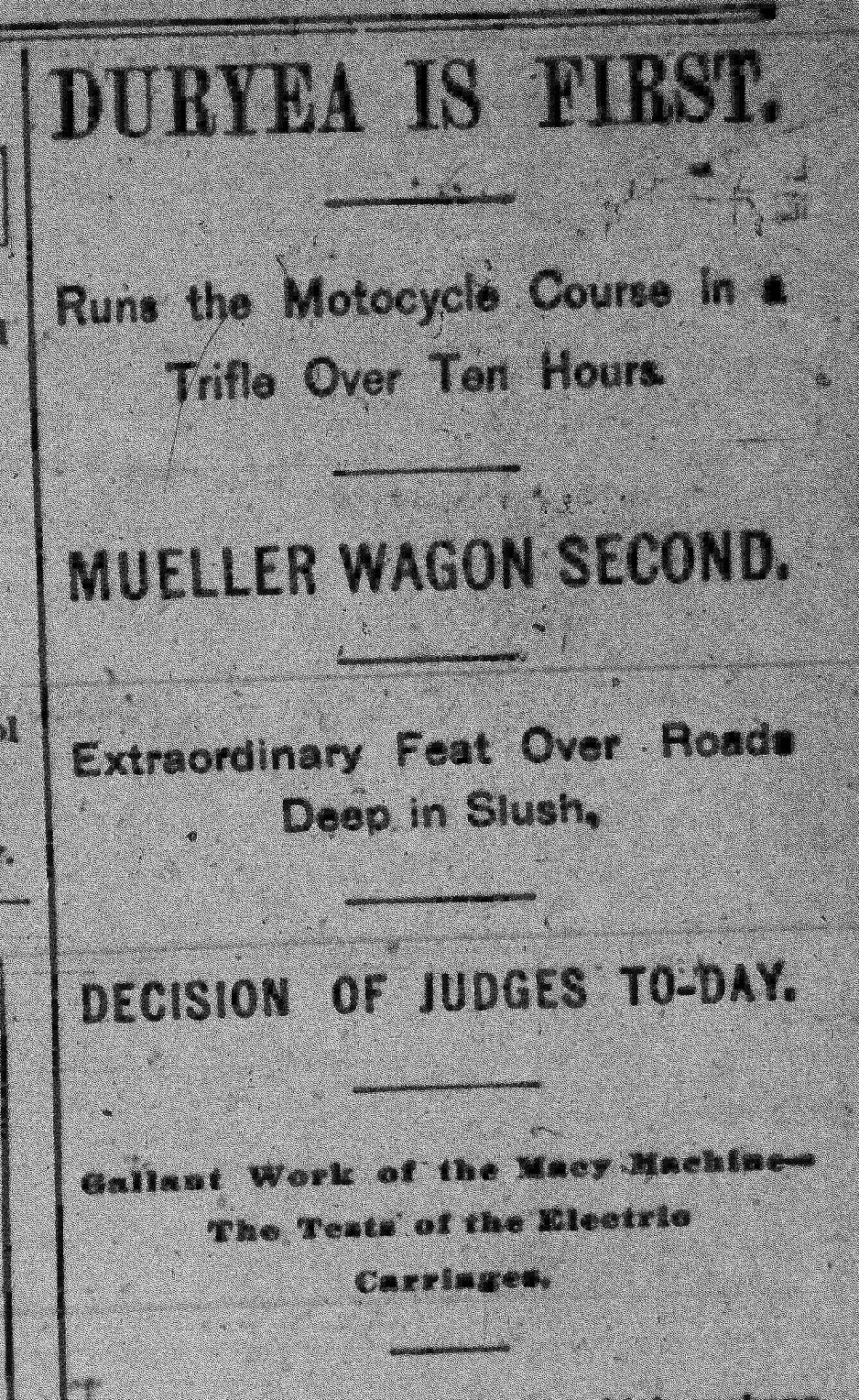
Front page of the Chicago Times-Herald on November 28, 1895, with a recap of the race.
Ultimately, the Times-Herald Race started what would become a revolution. Six years later, the first Chicago Auto Show was organized in 1901 to showcase the reliability and power of the personal vehicle, marking the start of an automotive tradition that has spanned more than a century of automotive development. Chicago also continued its history of motorsports well into the twentieth century. During the 1940s and ’50s, stock car racing made Soldier Field one of the premier venues in the nation for racing aficionados.
Additional Resources
- The Hieronymus Mueller & Co Benz can still be seen today, as it’s on exhibit at the Hieronymus Mueller Museum in Decatur, IL.
- Encyclopedia of Chicago entry on the Chicago Times-Herald Race of 1895.
- Encyclopedia of Chicago entry on the history of motorsports in Chicago.